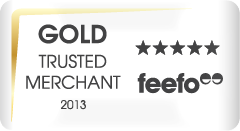4 minute read
I see a lot of ineffective, misguided marketing content. Could it be better to say nothing than something that offers little value to the reader? It is, albeit to me, logical that effective content starts with a strategy.
My experience is that you achieve quality engagement when the message is useful, purposeful, challenging and unique. This statement also infers that from a business’s perspective, to be effective content must also be measurable in its performance.
Recently I have seen a recipient of Feefo’s Trusted Service accreditation display this as a badge of honour on their TV ad. This is something that I enjoy seeing. The accreditation represents one of my proudest commercial achievements and what I consider as (still) very effective content.
The Challenge
Not long after I joined Feefo, the Customer Services Director asked me to prepare to send certificates to all customers showing their year’s average Service Rating. Some customers had only achieved an average rating of 50 something percent while others had the holy grail of 100%. (In Feefo terms, a Service Rating is the percentage of positive ratings a user receives; some of Feefo’s customers had thousands of ratings and reviews each month while some had only 100 over the year). Rewarding customers in such a broad way didn’t sit well with me.
After deliberation with my team, I proposed the Trusted Merchant Accreditation. The aim was to award two levels of accreditation, Feefo Trusted Merchant and Feefo Gold Trusted Merchant. Where a ‘merchant’ (the name Feefo used for its customers at this time) achieves an annual Service Rating of between 95 and 100 percent, they receive the Gold level award. A rating between 70% and 95% earned the Trusted Merchant accreditation. The ‘Highly Commended’ accreditation was for businesses that had not received many ratings, but those received were 100% positive.
Initially, the Directors were unhappy that some customers would miss out. In order for the accreditation to be valuable, a controlled criteria should be employed. My vision was for an exclusive club. This happened during December 2013. That Christmas break I printed hundreds of certificates, hundreds of letters and addresses and sat at home watching movies while stuffing hundreds of envelopes.

The inaugural Trusted Merchant Award digital asset (above).
In addition to certificates, my designer created digital badges that could be used online and in print.
[Stop! Haven’t you gone off piste here? How is this about effective content and strategy? You appear to be reflecting on a past glory that was quite a few years ago…
Fair comment.]
Content as a Part of Strategy
After joining Feefo, I had to present to the board my strategy for growing the company’s sales. I suggested several things related to creating effective content, including the use of the company’s greatest asset: its customers. I recognised that many customers did not actually feature Feefo’s digital assets on their website. They certainly didn’t mention the feedback in social media posts.
My Strategy was to grow sales by a) having more customers share their use of Feefo with their own customers and even competitors, b) create a community of high-achieving customers that other companies would want to be associated with and c) fill social channels with customers talking about their Feefo successes.
And it worked. Still does. A search on social media for #FeefoTrusted shows Feefo users that are proud of their customer service success.
The result is that there is, to this day, a stream of online and offline content that fits with the strategy. Seven years after its launch, the Trusted Service accreditation still goes strong. It’s been re-named to match Feefo’s current offering, but has at its core, the desire to reward a community of customers that achieve great customer service. The award produces effective content that delivers on what we set out to achieve at its inception that can be seen on social channels and in print and television adverts.
[So, if this article is about content being based on strategy, how does your experience relate to me?
Good question.]
Effective Content as a part of a Strategy
Social marketers have a belief that saying something, anything online keeps you and your brand front of mind for your prospect. My experience is that this is quite a wishy-washy claim. Arguably it is a belief of marketers that resist interrogation about the success or otherwise of their work.
Tracking makes it possible to count every click that an article receives and identify the onsite behaviour of the visitor, through to enquiry / purchase. With this the case, you should look to make sure that when you speak to your customer, you do so in a way that focuses on what you need from them in a way that they are able to hear.
You can create a social post about your latest humble brag or pose a question that you want to get a lot of answers to so that more people see your name… but what is your strategy? What are you actually trying to do?
When you write inline with your strategy, you have a document that has keywords that align with your company, objectives that support those of the business and language that your customers not just understand but want to hear. That is when you have effective content.
